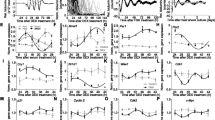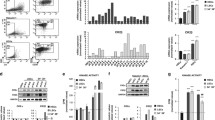Abstract
Per2 regulates other molecular and biochemical processes beyond their established role in the regulation of the mammalian circadian clock, herein we investigated the growth inhibiting potential of Per2 in human K562 leukemia cells and the underlying mechanisms .The results showed that over-expression of Per2 induced not only cell cycle arrest at G2/M phase but also an increase in apoptosis, which was confirmed by characteristic morphological changes, FCM and evident DNA fragmentation. Further experiments confirmed both up-regulation of P53 and down-regulation of CylinB1and C-myc. On the other hand, while P53 was found to be down-regulated. CylinB1 and C-myc were up-regulated. after Per2 knockdown. In leukemia mice, Per2 transfection was shown to suppress cellular proliferation and accelerate apoptosis of K562 cells. Moreover, fewer leukemia cells were found to have infiltrated into the livers and spleens of the mice from the Per2 transfected group as compared with those from the control group. In summary, Per2 displayed a significant anti-tumor effect through cell cycle arrest and apoptosis induction in K562 cells. These data further support the emerging role of the circadian clock in critical aspects of cancer development and thorough research is underway on the mechanism of Per2 in the leukemia.




Similar content being viewed by others
References
Reppert SM, Weaver DR (2002) Coordination of circadian timing in mammals. Nature 418:935–941
Schibler U, Sassone-Corsi P (2002) A web of circadian pacemakers. Cell 111:919–922
Lowrey PL, Takahashi JS (2004) Mammalian circadian biology: Elucidating genome-wide levels of temporal organization. Ann Rev Genomics Hum Genet. 5:407–441
Ko CH, Takahashi JS (2006) Molecular components of the mammalian circadian clock. Hum Mol Genet 15:271–277
Zheng B, Larkin DW, Albrecht U et al (1999) The mPer2 gene encodes a functional component of the mammalian circadian clock. Nature 400:169–173
Zheng B, Albrecht U, Kaasik K et al (2001) Nonredundant roles of the mPer1 and mPer2 genes in the mammalian circadian clock. Cell 105:683–694
Fu L, Lee CC (2003) The circadian clock: pacemaker and tumour suppressor. Nat Rev Cancer. 3:350–361
Canaple L, Kakizawa T, Laudet V (2003) The days and nights of cancer cells. Cancer Res 63:7545–7552
Chen ST, Choo KB (2005) HouM.F., Yeh K.T., Kuo S.J. and Chang J.G, Deregulated expression of the PER1; PER2 and PER3 genes in breast cancers. Carcinogenesis. 26:1241–1246
Gery S, Gombart AF, Yi WS, Koeffler C, Hofmann WK (2005) and Koeffler H.P, Transcription profiling of C/EBP targetsidentifies Per2 as a gene implicated in myeloid leukemia. Blood. 106:2827–2836
Gery S, Virk RK, Chumakov K, Yu A (2007) and Koeffler H.P, The clock gene Per2 links the circadian system to the estrogen receptor. Oncogene. 26:7916–7920
Hua H, Wang Z, Halberg F et al (2006) Circadian gene mPer2 overexpression induces cancer cell apoptosis. Cancer Sci. 97:589–596
MingYu Yang, Yi-Chang Liu, Sheng-Fung Lin et al (2006) Downregulation of circadian clock genes in chronic myeloid leukemia: alternative methylation pattern of hPER3. Cancer Sci 97:1298–1307
Lévi F, Filipski E, Iurisci I, Li XM, Innominato P (2007) Cross-talks between circadian timing system and cell division cycle determine cancer biology and therapeutics. Cold Spring Harb Symp Quant Biol 72:465–475
Fu L, Pelicano H, Liu J, Lee C (2002) The circadian gene Period2 plays an important role in tumor suppression and DNA damage response in vivo. Cell 111:41–50
Elledge SJ (1996) Cell cycle checkpoints: preventing an identity crisis. Science 274:1664–1672
Shah JV, Cleveland DW (2000) Waiting for anaphase: Mad2 and the spindle assembly checkpoint. Cell 103:997–1000
Fluge O, Bruland O, Akslen LA, Lillehaug JR, Varhaug JE (2006) Gene expression in poorly differentiated papillary thyroid carcinomas. Thyroid. 16:161–175
Hansel DE, Dhara S, Huang RC (2005) CDC2/CDK1 expression in esophageal adenocarcinoma and precursor lesions serves as a diagnostic and cancer progression marker and potential novel drug target. Am J Surg Pathol 29:390–399
Ito Y, Takeda T, Sakon M, Monden M, Tsujimoto M, Matsuura N (2000) Expression and prognostic role of cyclin-dependent kinase 1 (cdc2) in hepatocellular carcinoma. Oncology 59:68–74
Matsuo T, Yamaguchi S, Mitsui S, Emi A, Shimoda F (2003) and Okamura, H, Control mechanism of the circadian clock for timing of cell division in vivo. Science 302:255–259
Granda TG, Liu XH, Smaaland R, Cermakian N, Filipski E, Sassone-Corsi P, Lévi F (2005) Circadian regulation of cell cycle and apoptosis proteins in mouse bone marrow and tumor. FASEB J 19:304–306
Vogelstein B, Lane D (2000) and Levine A.J, Surfing the p53 network. Nature 408:307–310
Liu G, Chen X (2006) Regulation of the p53 transcriptional activity. J. Cell. Biochem. 97:448–458
Stark GR, Taylor WR (2006) Control of the G2/M transition. Mol Biotechnol 32:227–248
Hu R, Aplin AE (2008) Skp2 regulates G2/M progression in a p53-dependent manner. Mol Biol Cell 19:4602–4610
Blum-Jensen P, Hunter T (2001) Oncogenic kinase singaling. Nature 411:355–365
Vira M, Henriksson M (2006) The Myc oncoprotein as a therapeutic target for human cancer. Semin Cancer Biof. 16:318–330
Wu Ch, Riggelen J, Yetil A (2007) et a1, Cellular senescence is an important mechanism of tumor regression upon c-Myc inactivation. PNAS. 104:13028–13033
Evan GI, Vousden KH (2001) Proliferation, cell cycle and apoptosis in cancer. Nature 411:342–348
Acknowledgements
We would like to show our thanks to Professor Steven Reppert (University of MassachusettsMedical School, USA) for his offer of the eukaryotic expression vector pcDNA 3.1-Per2; we also extend our thanks to Prof. Tong-chuan He at Chicago Medical Center in America for his kind help in technical expertise and writing instructions. This work was supported by the National Science Foundation of China Grants No.30600748 to Wen-li Feng.
Author information
Authors and Affiliations
Corresponding author
Rights and permissions
About this article
Cite this article
Sun, Cm., Huang, Sf., Zeng, Jm. et al. Per2 Inhibits K562 Leukemia Cell Growth In Vitro and In Vivo Through Cell Cycle Arrest and Apoptosis Induction. Pathol. Oncol. Res. 16, 403–411 (2010). https://doi.org/10.1007/s12253-009-9227-0
Received:
Accepted:
Published:
Issue Date:
DOI: https://doi.org/10.1007/s12253-009-9227-0




